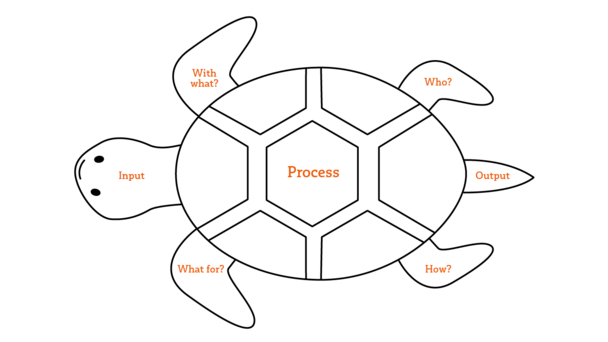
QM Knowledge: Process Management
Process management is a method for designing, controlling and continuously optimizing all of a company's processes. Read on for everything you need to know about process management. Read more

Processes form an integral part of management systems – it is not for nothing that standards such as ISO 9001 set requirements for dealing with processes. However, structured process management is also an important prerequisite for a company's success outside of issues relating to standards and certifications. Accordingly, there is a great need for a simple and effective tool for process analysis. One such tool is the turtle diagram.
The turtle diagram enables an analysis of the most important framework conditions of a process as part of process management. Their representation in this type of view is reminiscent of the body parts of a turtle, which explains the name “turtle diagram”.
You can find this content here:

Simple representation of a turtle diagram in process management
A turtle diagram consists of various elements relevant to the process analysis. These are represented by the body parts of the eponymous turtle: the head stands for the input (What is needed?), the tail for the output (What is delivered?; in some representations input and output are reversed). The process owner or person responsible can be noted above the stylized turtle and the process risks and opportunities can be noted below the turtle. The other factors are represented by the four legs of the turtle:
For a better understanding, the turtle diagram is described below using a fictitious example from production. A turtle diagram in incoming goods could contain the following elements:
The delivered goods and the delivery documents are available as input, as well as the linked predecessor processes. The equipment or tools (With what?) can be test and measuring equipment and the software used, but communication tools such as e-mail are also possible. Contributors (Who?) are employees in the warehouse and the people who check the quality of the delivered parts. Performance indicators (What for?) could be, for example, the number of accepted or rejected deliveries, the average inspection time or the error rate. The "How?" is then defined by quality standards, procedural instructions or similar.
The person responsible for the process could be the head of purchasing.Risks could include incorrect deliveries of goods, delays in incoming goods or inadequate quality controls; one possible opportunity would be to reduce random sample inspections, for example by optimizing outgoing goods at the supplier's premises. In addition to the goods themselves, the output of the process then consists of an inspection report and possibly updated data on stock levels. Linked follow-up processes also form part of the output.
The example of a turtle diagram in production shows that it is a quick and clear method of process analysis. In this way, the turtle method supports the effective execution and improvement of processes. The completed diagram also forms a process profile with all the key features of the process.
As the turtle diagram provides the most important information about the process at a glance, it not only significantly increases the efficiency of process management when it is created, but also when it is interpreted. At the same time, the turtle method increases transparency for all those involved. As a result, the acceptance of the entire process management can also be increased.
Of course, the possibilities of turtle diagrams are not limitless: although they help to understand a process, they do not depict the process itself in detail. The individual process steps or sequences are therefore not recognizable. Other forms of representation can therefore be used, such as process descriptions in text form or flowcharts for process visualization.
Even though ISO 9001 does not explicitly require the turtle diagram for QM, it is a good option in process management for ISO 9001 certified companies: This standard requires that organizations "establish, implement, maintain and continually improve a quality management system, including the processes needed and their interactions". The standard also stipulates that processes for the quality management system must be defined. This includes, among other things, inputs, outputs, interactions, performance indicators, resources and responsible parties. By including the aspects mentioned, the turtle diagram can therefore provide support in fulfilling ISO 9001 – as well as other (management system) standards.
However, the possibilities of the turtle method are not limited to compliance with standards such as ISO 9001: as a proven and standardized methodology, it supports the establishment and further development of processes, thus contributing to effective process management and therefore to the success of the company. For efficient use of the turtle method, it is advisable to pay attention to integration with other process management tools such as documents. In this way, the associated process descriptions or workinstructions can be quickly accessed from the process.
In addition, clear communication should be at the heart of the entire process management, allowing all those involved to maintain an overview and, ideally, to participate in the further development of the processes. After all, processes should of course also be reviewed regularly. A specialized software solution can support all these process management tasks by providing the aforementioned resources efficiently and reliably and enabling seamless collaboration in process management.
Comments
No comments